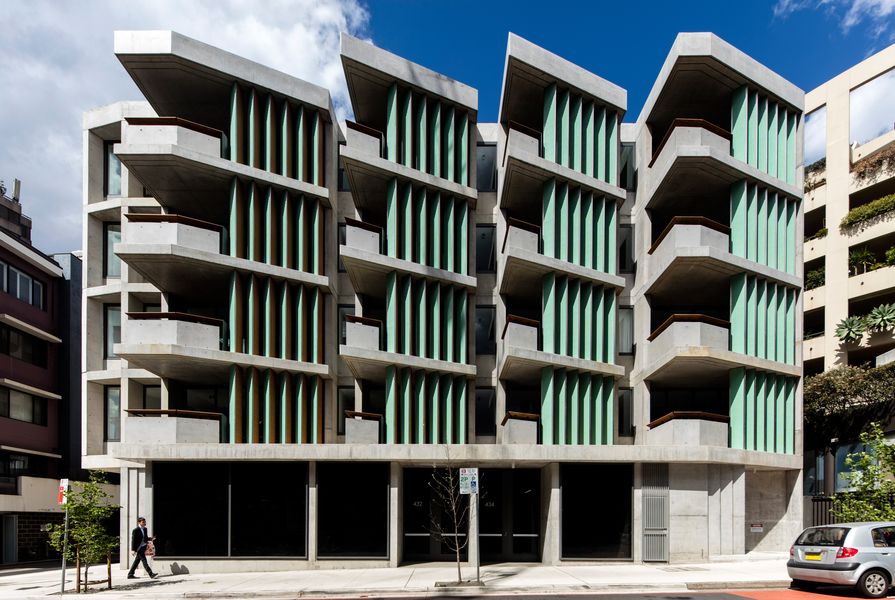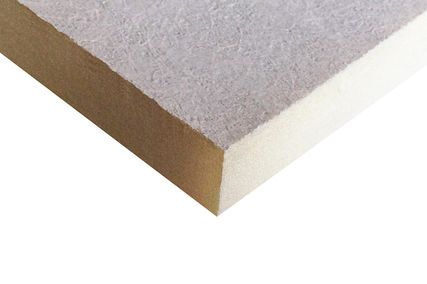Off-form concrete has become Candalepas Associates’ signature. Usually smooth in finish, it is a brave move in a country like Australia, which is not known for the quality of its off-form work. Many – probably most – of the examples of smooth off-form that you see around town have been touched up with a skim coat or cement paint to hide the bubbles, blotches and other blemishes that are the hallmark of our local product. However, Candalepas Associates seems to have discovered how to get it right.
In many respects, The Surry apartment block in Sydney’s Surry Hills is a typical Candalepas project. They are usually easy to pick – and not just because they employ off-form concrete or because they are consistently fine examples of architecture; the work is always very rigorous and disciplined. But, as well, each project includes a surprising touch that, although not easily explained in a functional or practical sense, adds to the joy and artistry of the work. Angelo Candalepas is a disciple of beauty and romance who is prone to bouts of poetry and classical piano, and it seems important to him that, in the practice’s work, there is always something of the sublime or idiosyncratic to lift us above the mundane. Sometimes, the work veers into austerity – but then a touch of colour, the warmth of timber, or another element of craftsmanship brings back a human feel. All the work appeals to our senses, responding directly to the scale and movement of the body.
The block’s main entry is tucked around the corner on a side street, away from the arterial road.
Image: Brett Boardman
In its bones, Candalepas Associates’ work is classically European and would happily reside somewhere in one of the nations fronting the Mediterranean. It is designed to age gracefully and assumes that it will be around for many years. Materiality is at the core and is expressed deliberately as a major part of the aesthetic.
In 1995, Candalepas Associates won a national design competition for what became known as the Pyrmont Point Apartments (completed in 1998) in Sydney. Drawing on the architecture of traditional Greek villages, it is a heavily rusticated and expressive building that was a significant departure from the standard developer-driven unit designs of the time. This project not only set up Candalepas for 25 years of apartment design evolution; I believe it also had an influence on the expectations and quality of the commercial apartment market going forward. It was probably this building that introduced the external sliding/folding shutter that has become a must-have for modern apartments, just as spa baths and bidets once were.
The Surry continues the pattern of renewal of this old rag-trade quarter of inner Sydney, where existing warehouses have been transformed into New York-style loft apartments, while underutilized sites are cleared for new multiresidential buildings that squeeze out every square centimetre of developable space. On the whole, the transformation has been positive and this is now a desirable place to live for the young and mobile as well as a few stylish downsizers.
Screens are used to maintain privacy in the tight matrix of apartments on narrow streets.
Image: Brett Boardman
The Surry exemplifies urbane city planning, with the building form reinforcing the street edge and an internal courtyard carved out to create an L-shaped plan that maximizes light and cross-ventilation to the apartments. The street level is activated by commercial tenancies facing busy Elizabeth Street. The apartments’ entry and foyer is tucked around the corner in quieter Butt Street, where an impressively scaled steel security door leads into an austere lobby of concrete and terrazzo that steals southern light from the courtyard above.
Above the commercial tenancies, on one side of the “L,” are four levels of studio, two- and three-bedroom units. In the two-storey, two-bedroom crossover units on the other part of the “L,” facing Butt Street, the bedrooms on both the north and south facades have access to natural light.
The Elizabeth Street elevation has a stepping profile that turns to the best view: north along Elizabeth Street and toward the city skyline. The divisions nicely mimic the scale and rhythm of the typical Sydney terrace house rows that once occupied this part of Elizabeth Street. The balconies include triangular blades clad in turquoise and tangerine ceramic tiles (the surprising touch), and a large, flat, timber leaning rail that lifts them above the ordinary.
Along the northern facade, to Butt Street, light is introduced at high level with glass bricks (in a nod to the warehouse architecture that once made up much of this suburb). In the tight matrix of apartments looking at each other across narrow streets, sliding screens and blinds are an important device to maintain privacy. The screens showcase the architect’s careful approach to bespoke detailing.
The Surry by Candalepas Associates.
Image: Brett Boardman
These are very compact inner-city apartments where the maximum number of residences and bedrooms possible within the envelope controls has been realized. In less skilful hands, the development could easily have been claustrophobic and overworked. Perhaps a couple of the two-bedroom Butt Street apartments are a little squeezy, and the three-bedroom apartments might have been better left as two, but it gets all the basics right: good orientation, good natural light, good cross-ventilation (only the studio apartments are single orientation), good privacy, good acoustics. And this is ultimately why these dwellings are successful and very livable.
A communal roof terrace caps off the building, with the same long views to the city horizon, and facilities that mean the space will be used (barbecue, sink, toilet and landscaping). It has a welcome sense of openness that balances the tightly planned apartments below.
The interior design of The Surry, by Lawless and Meyerson, is respectful, with a reserved palette in varying tones of white, black and grey. It leaves room for the inhabitants to personalize their spaces as they see fit.
The interiors of The Surry are designed by Lawless and Meyerson.
Image: Brett Boardman
The play of light on walls that have deep reveals, bending forms and stepping profiles enlivens the grey concrete that could be relentless if left flat and undetailed. Candalepas understands the craft of making in-situ concrete buildings – the reality of form joints and tie bolts, the opportunities for texture – as well as the limitations of a material that you only get one go at. The practice also utilizes the finer scaled detailing of timber rails and screens, sliding aluminium panels and ceramic tiles to counter the larger expanses of raw concrete.
In Sydney, the importance of densification – and doing it right – cannot be overemphasized. The days of low-density greenfield development in an ever-expanding city footprint are not sustainable and should be behind us. Apart from Potts Point and Elizabeth Bay, there are few traditional examples of high-quality, high-density apartment neighbourhoods in Sydney. What we see in Potts Point, in particular, is a coherent and dignified streetscape where each building responds to the street alignment and respects the adjoining building, so that access to natural light, ventilation and privacy is secured and views are shared around. In this typology, the fundamentals of light, ventilation, privacy and acoustics determine the success of the development. The rest is really just style.
This high-quality urbanism is now spreading to Surry Hills and The Surry provides exactly the sort of template for infill development that local councils and the state government should be promoting.
Credits
- Project
- The Surry
- Architect
- Candalepas Associates
Sydney, NSW, Australia
- Project Team
- Angelo Candalepas, Jeremy Loblay, Lachlan Seegers
- Consultants
-
Accessibility consultant
ABE Consulting
Acoustic consultant/BASIX/ESD Cundall
BCA Steve Watson and Partners
Builder Growthbuilt
Civil, structural and facade engineer Taylor Thomson Whitting (TTW)
Fire consultant Defire
Heritage consultant John Oultram Heritage and Design
Interior architect Lawless and Meyerson
Landscape consultant 360 Degrees Landscape Architects
Mechanical, lighting and electrical engineer Erbas
Planner Mersonn Pty Ltd
Traffic consultant Terraffic
Waste consultant Elephants Foot
- Aboriginal Nation
- Built on the land of the Gadigal people of the Eora nation.
- Site Details
-
Location
Surry Hills,
Sydney,
NSW,
Australia
Site type Urban
- Project Details
-
Status
Built
Completion date 2020
Category Residential
Type Multi-residential
Source

Project
Published online: 18 May 2021
Words:
Andrew Nimmo
Images:
Brett Boardman
Issue
Architecture Australia, January 2021






























